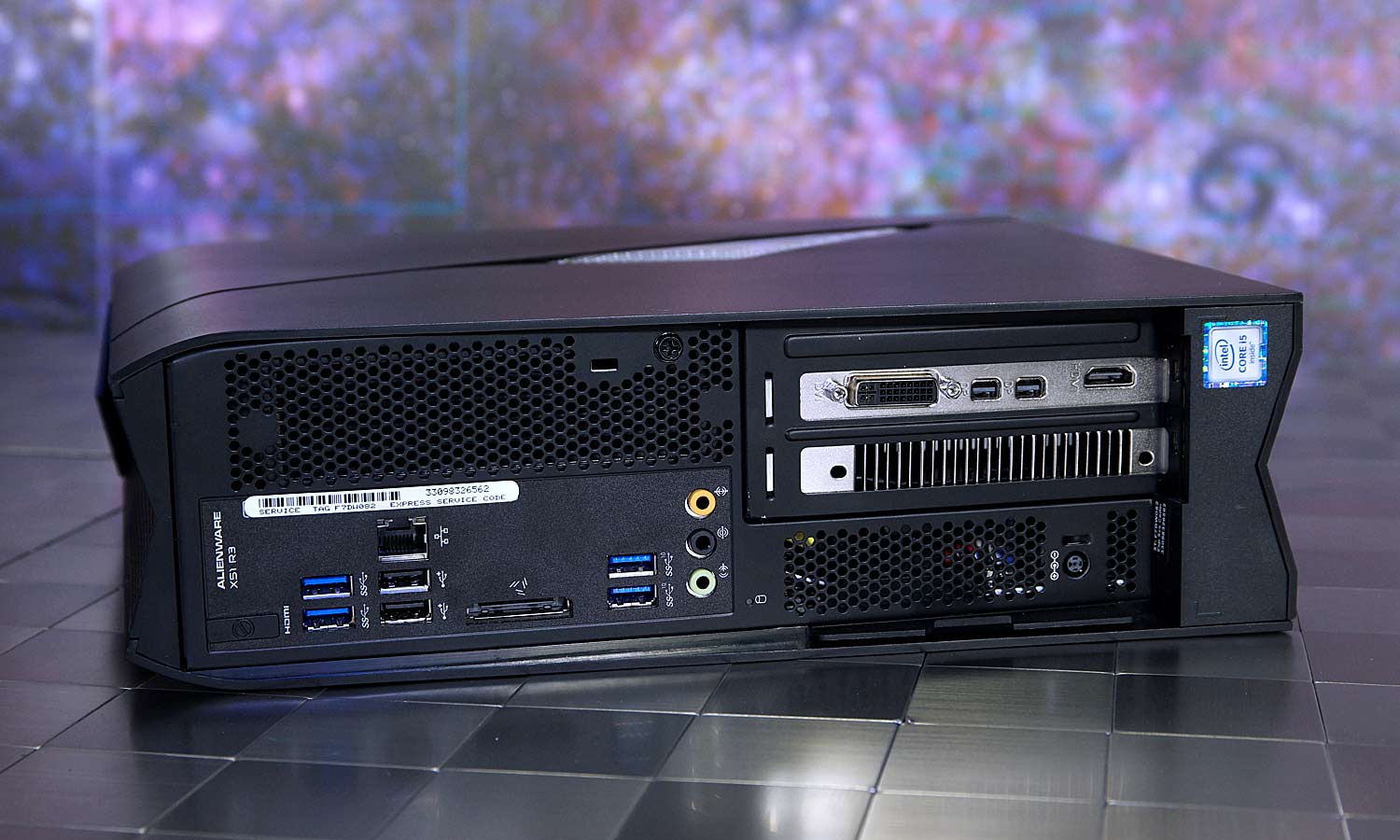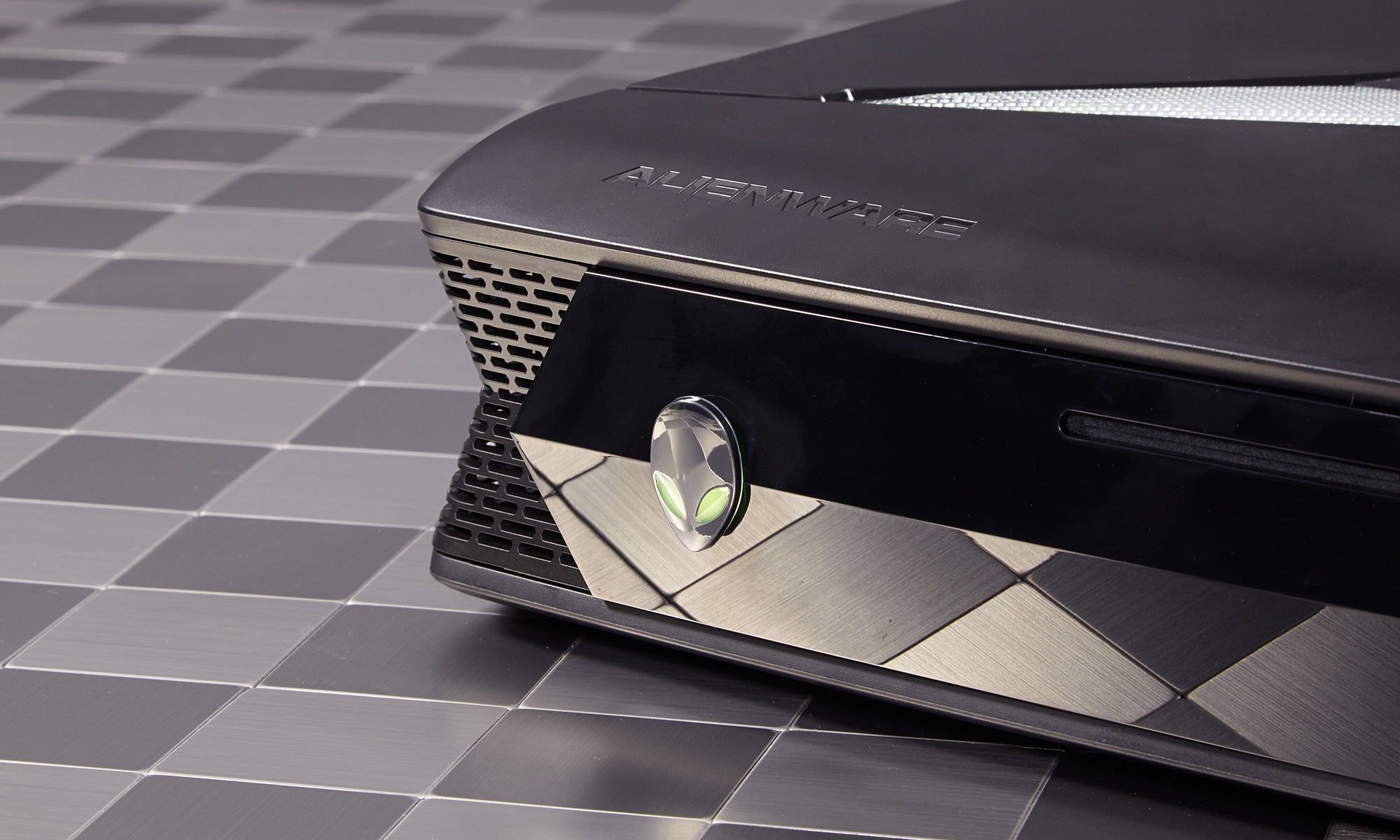Tom's Guide Verdict
The Alienware X51 is an attractively compact gaming desktop and a powerful entry point into VR gaming.
Pros
- +
Attractive, living-room-friendly design
- +
VR-ready gaming performance
- +
Customizable lighting
Cons
- -
Weaker CPU performance than competitors'
- -
Can't be configured with GTX 980
Why you can trust Tom's Guide
A Gateway to Virtual Reality
With its console-like looks and relatively affordable price, the Alienware X51 has long been a welcoming gateway to PC gaming. Now, it's also a gateway to virtual reality. The new X51 R3 (starting at $1,199 on Dell.com, roughly $1,499 as tested) is optimized for the Oculus Rift, sporting an Intel Core i5 processor and an Nvidia GTX 970 GPU designed to handle VR gaming without a sweat. Alienware's sleek PC is an excellent package for those crossing into PC gaming, though people seeking the highest-end graphics options should look elsewhere.
Design
The Alienware X51's design hasn't changed for its latest, VR-ready configuration, and I'm not complaining. The X51 continues to be one of the sexiest gaming desktops on the market, with triangular LED lights and a curvy, slim chassis that looks more like a game console than a Windows PC.

At 13.5 x 12.5 x 3.74 inches, the X51 looks slick regardless of whether you stand it vertically or slide it horizontally under your TV — you can even rotate the alien head on the front of the PC to fit your orientation. Alienware's desktop is similar in size to Microsoft's Xbox One (13.1 x 10.5 x 3.25 inches) but not quite as sleek as Sony's PlayStation (12 x 10.8 x 2 inches). Still, the X51 is noticeably slimmer than other living-room-friendly PCs, such as the Maingear Drift and the Origin Chronos.
Ports and Upgradability
True to its console-like design, the X51 packs two USB 3.0 ports as well as headphone and mic jacks in the front for easy plug-and-play. In the back, you'll find two USB 2.0 ports, two USB 3.0 ports, two extra-fast USB 3.1 connections, a Gigabit Ethernet jack and a proprietary port for Alienware's Graphics Amplifier.

The PC sports front, side and subwoofer inputs for audio, while its Nvidia GeForce GTX 970 graphics card packs an HDMI port, two mini DisplayPorts and a DVI port for whichever combination of monitors you might use.
Alienware Command Center

As with any Alienware machine, you can monitor the X51's performance and set all kinds of crazy lighting patterns using Alienware's robust, fairly useful Command Center app.
The AlienFX portion of the app lets you customize the colors of the two LED strips on either side panel as well as the glowing alien head in the center. You can tweak each light individually, whether you want the entire PC to glow blue or program a fiesta of different hues across the machine's three zones. You can also have certain color patterns appear during specific events, such as when you receive an email.
The X51 continues to be one of the sexiest gaming desktops on the market.
When you're done setting up the perfect light show, you can use Command Center to view the temperature of the PC's components and adjust fan speeds if things are getting too hot. You can also set various sleep and wake-up options, as well as fiddle with the PC's overclocking controls if you want extra speed.
MORE: Our Favorite Gaming Keyboards
If you have an Alienware Graphics Amp plugged in, you can manage it here. You can also set specific game modes that can, for example, trigger custom lighting settings and open a specific web page every time you launch your favorite title.
Gaming Performance
Armed with an Nvidia GTX 970 graphics card with 4GB of VRAM, the X51 packs high-end gaming performance into its compact frame. This slim rig handled Rise of the Tomb Raider's gorgeous lighting, detailed character models and intense cinematics with no issues, treating me to 50 frame-per-second gameplay with the graphics cranked up to 2560 x 1440.

On the game's benchmark, the X51 churned out a smooth 58.8 fps at 1080p with graphics maxed out. The PC even mustered some respectable 4K performance at 35.6 fps on low graphics but crawled to an unplayable 19.9 fps on very high graphics settings.
The Alienware X51 chewed through the tactical shooting of Rainbow Six Siege, running the game's benchmark at 107 fps at 1080p with the graphics cranked all the way up. When we upped the game's graphics to 4K, the X51 posted perfectly playable frame rates of 60 fps on low settings and 34.2 fps on high.

Alienware's PC scored a 2,900 on the 3DMark Fire Strike Ultra Test, trailing the GTX 970-powered iBuyPower Revolt 2 (2,695) and the Origin Chronos (2,900).
VR Readiness
Alienware promises that its VR-ready PCs have already been tested with the Rift, but just to be safe, I put the PC through a few benchmarks. As expected, the X51 checked off the necessary boxes on the Rift Compatibility Tool, which scans your system to ensure you have the proper CPU, GPU, RAM and USB ports for virtual-reality gaming.

The X51 also got the thumbs-up on Valve's more intensive SteamVR Performance Test, which runs a Portal-themed demo and rates PCs as Not Ready (red), Capable (yellow) or Ready (green). The X51 landed in the green bracket, with an average quality of 6.2 (which Valve considers high) and zero dips below 90 fps.
Overall Performance
Packing an Intel Core i5-6600K processor with 16GB of RAM, the X51 has tons of multitasking muscle to back up its gaming prowess. The desktop never faltered under the slew of tasks I threw its way, even as I watched five Twitch streams, did some work in Google Docs, downloaded a game on Steam and ran a system scan all at once.

The X51 netted a 12,526 on the Geekbench 3 overall performance test, trailing the Core i7-6700K-powered Revolt 2 (15,883) and the Chronos (18,557).
Despite falling behind the competition in basic CPU performance, the X51 posted strong file-transfer speeds, thanks to its zippy 256GB solid-state drive. The PC copied 4.97GB of mixed media at a quick 279.34 MBps, outpacing the Revolt 2's 240GB SSD (146 MBps) as well as the Chronos' 250GB SSD (171.38 MBps).
Configurations and Graphics Amp

Alienware offers two key configurations of its Rift-ready Alienware X51. Your cheapest option starts at $1,199, which gets you an Intel Core i5-6400 processor; 8GB of RAM; a 1TB, 7,200-rpm hard drive and an Nvidia GTX 970 graphics card. A pricier $1,499 config ups the RAM to 16GB, and trades the former model's hard drive for a 256GB SSD.
You can have the entire PC glow blue or program a fiesta of different hues across the machine's three zones.
If you're looking to get everything you need for VR in a single package, you can get both versions of the X51 bundled with the Oculus Rift for $1,599 and $1,999, respectively. Alternatively, you can get a $200 voucher toward the X51 if you buy the $599 Oculus Rift separately.
We tested a custom version of the $1,499 configuration, which packs an Intel Core i5-6600K processor and both a 1TB hard drive as well as a 256GB SSD.
While both X51 configurations are VR-ready out of the box, there's no option to configure either of them with a GTX 980 or 980 Ti card if you want extra-strong gaming performance.
MORE: The Best Gaming Desktops Available Now
You can, however, bump the X51's graphics power with the optional Alienware Graphics Amp, an external device that houses up to an Nvidia GTX Titan X or an AMD R9 Nano. The amp costs $200, which doesn't include the cost of whichever graphics card you choose to put inside it.
Bottom Line

The Alienware X51 continues to be a great entry point into PC gaming, whether you want to get VR-ready without any hassle or are simply looking to ditch your console. The machine's GTX 970 graphics card can cruise through modern games at fairly high settings, and its slim frame and customizable lights make it worthy of your entertainment center.
While it works well out of the box, this particular Alienware X51 can't be configured with a GTX 980 or 980 Ti, which limits its potential for those seeking the best graphics quality possible. If you're looking for more options, consider the Origin Chronos (starting at $1,799), which offers a wealth of aesthetic and component choices at the point of purchase. Still, Alienware's PC looks a bit nicer sitting on your shelf, and if you're coming from PlayStation or Xbox, that could make all the difference.
Mike Andronico is Senior Writer at CNNUnderscored. He was formerly Managing Editor at Tom's Guide, where he wrote extensively on gaming, as well as running the show on the news front. When not at work, you can usually catch him playing Street Fighter, devouring Twitch streams and trying to convince people that Hawkeye is the best Avenger.

